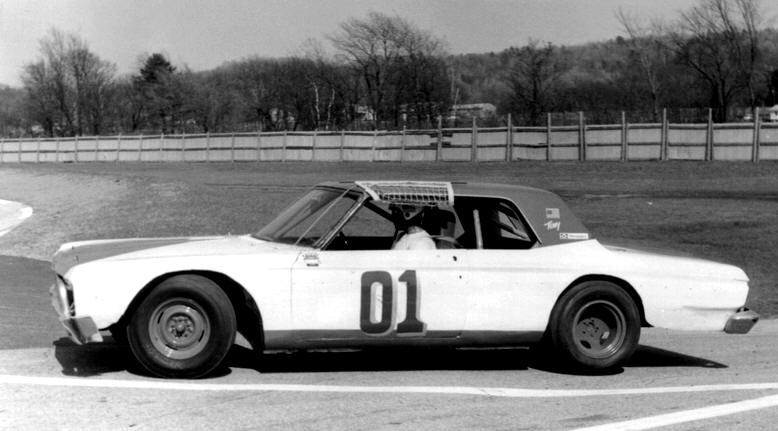The choice of
names for this class of pony cars could have come from NASCAR’s semi – big –
league class which featured the same kinds of cars [although not with sixes].
It first called them Grand Touring cars, but sounded too much like the
international road racing bunch: so, they settled later on Grand American.
This was not actually original to NASCAR. Harvery Tattersall had used the term
for a class of cars he ran in the Northeast that used a lot of his Riverside
Speedway regulars and which was a poor man’s imitation of the NASCAR Grand
Nationals.
Waters recalls the time when the division
specs were first laid out. He wrote : “When
the G-A division was started, the engine rules were not very user friendly.
You had to run flat top pistons with stock bore..which made it tough to find a
good block. When Richard (Buzzi) built his car, the first motor was a .030
over. Some of us knew it, but it wasn’t a big deal. If I remember correct, he
didn’t run it long before he was torn down and caught. I told him that he
should have slowed down.”

Courtesy of Mark Austin
TR Waters’ potent Camaro at Barre, with the Barton car in the
background.
T R says that, when the word came out about the division,
he set about building a really good one right away, in the same garage in
Washington as Tucker – who had, by that time, purchased a Dave Dion Ford
Torino and was ready to try the late model sportsman division. Tucker had been
a real force in the Hurricanes with a Ford, as had his close friend Richard
Buzzi. Now Buzzi would head for dominance in the sixes and Tucker would
struggle with an under – funded LMS campaign.
Waters took on Tucker’s number 28, and would use the Z28 version
with Driver Larry Caron, another former Hurricane star who would go on to
excel in both the Grand Americans and the late models. Waters cars were good
looking and fast; but, he points out there were limitations to the six
cylinder power plants. He wrote to me: “By
the time I had the Z 28 car, I'd learned a lot about the chevy six engine. I
still couldn’t drive one..haha. The engines would not run over 5800 rpm or so
without something breaking. If the crankshaft survived, the front balancer
would come loose....or the flywheel would. It was just the harmonics of these
motors. We ran the Z28
car with 3.70 gears at Catamount. We were very close to the rpm limit. I had
three different 3 speed transmissions that all had different gear ratios.
”

Denis LaChance Photo Ladabouche Collection
Richard Buzzi and his chirping Camaro sit at Catamount,
waiting to prey upon the unsuspecting
other Grand Americans. Note the closeness of the group, with rival Larry
Caron’s ad on the side.
Henry Van Acker is ahead of Buzzi, and Jay Yantz is first on the track for
practice.
The division started out slowly, as would any
new class of racing. The head start afforded to that handful of teams who
chose to run with [and get pushed around by] the well – established Hurricane
cars in that single limited sportsman season helped to lend some stability in
1977. Chelsea’s Charlie Ladd, a friend of Waters and a man not known for
towering racing accomplishments, won the inaugural Grand American feature.
But, the class of an already – impressive division was Larry Caron, Richard
Buzzi, Jay Yantz, and Henry Van Acker.
The division was fascinating, if one took the
time to actually pay attention. Although the Chevy Camaro was the most
plentiful and arguably the most successful, Yantz was very strong in the #64
Mustang, and George McRae [and later, brother, Barney] was fielding a
particularly impressive AMC effort. Sponsored by the local Buyers Digest
paper, he actually fielded a white model and his familiar orange car at very
times during the year.
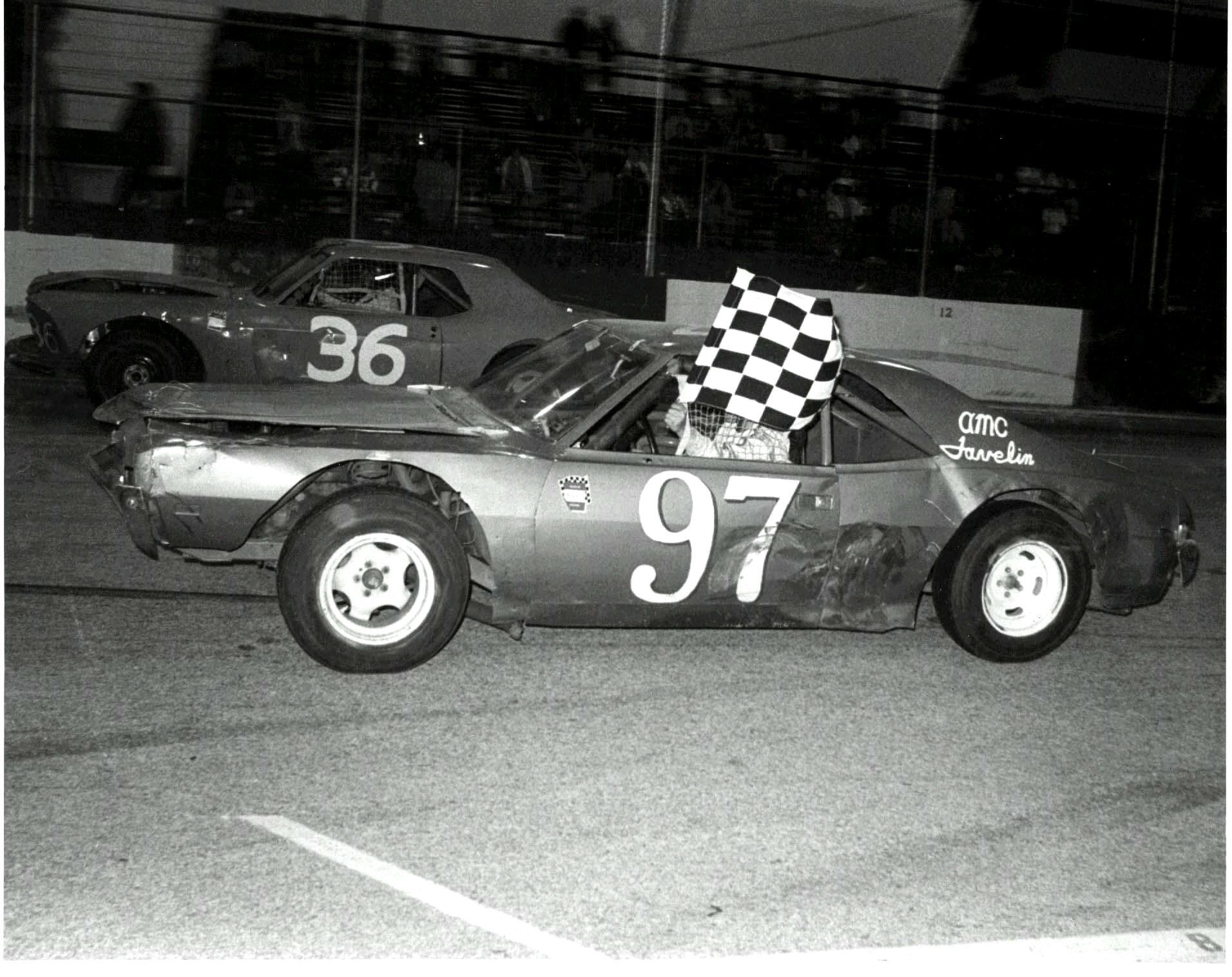
All Three
Photos -
Ladabouche Collection
Dave Gibbs
[above] and George McRae kept the AMC cars in the spotlight. Below – Jay
Yantz’s Mustang led the Ford contingent and Paul Donahue ran one of the only
Mopars in the Grand Americans.
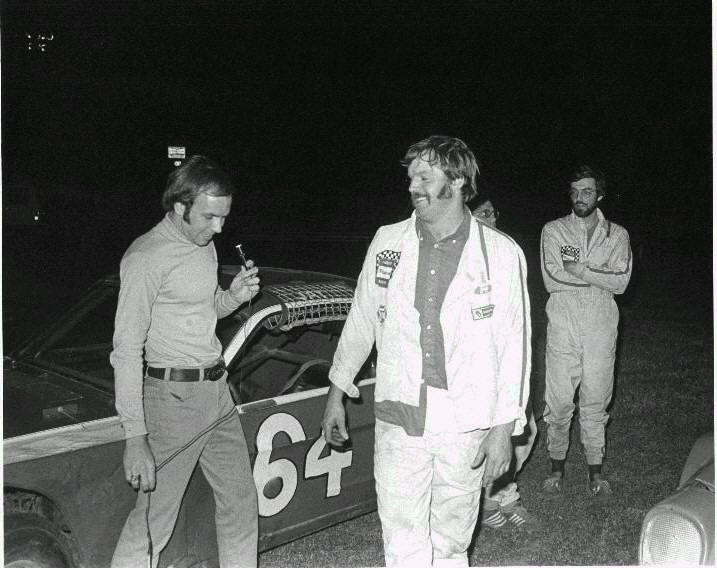

Ladabouche Photo
The Grand
Americans were populated with a good mixture of teams. Besides the
aforementioned, there was New Yorker Bob Wood, Vermonter Monty Jarvis, Dave
Gibbs, and Mopar driver Paul Donahue. Woodstock’s Bruce Jaycox fielded a full
– bodied Ford Fairlane with more success than one would expect for a car of
that weight. Future two – time Busch Grand National North star Jamie Aube
fielded a Camaro, and his North Ferrisburgh neighbor, Harry Rathburn built two
almost – identical Camaros, painting them in an unusual brown and yellow
scheme. Rathburn’s cars would be starter opportunities for such later stars as
Kevin Boutin, Greg Lyman, and Aube.
The division, while dwarfed in attention by
the burgeoning late model sportsman tours concept, definitely had its own
story lines and drama which wads entertaining to those who took the time to
observe. The first big story was Richard Buzzi and his chirping Camaro. Only a
few people know what Buzzi did to his car to have it produce a characteristic
chirpy sound, but – whatever it was – the car was darned near untouchable.
Buzzi would be the champion for the first two years, in the face of some very
competent rivals.
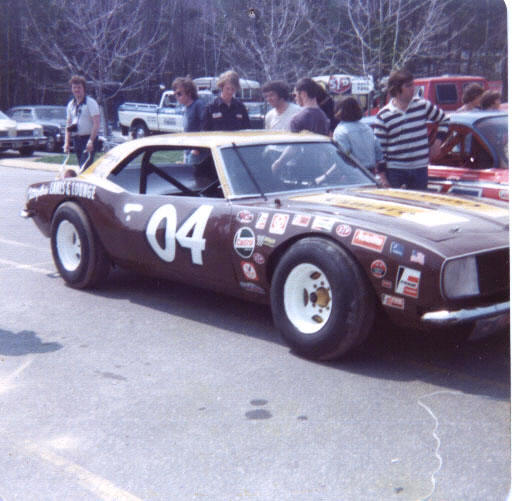
Ladabouche Photos
Harry Rathburn’s team
car draws quite a crowd of the Who’s Who in Catamount Support Divisions for
that time.
Visible are Greg Lyman, Brad Wright, George LeClaire, Randy Chapin, and Joe
Myers. Below - The other
Rathburn car.
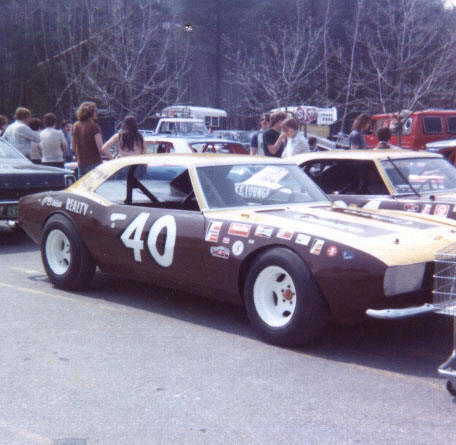
Tom Waters says, of Buzzi: “I
can remember having my G-A car, and then going over to Richard Buzzi's house
as he was building his....thinking "this thing is going to be fast". It sure
was. And it was just as fast with the legal motor too.. I think his was the
first year they allowed box tubing rear frame sections.
Larry (Caron) was helping
Richard at that time, as he wasn’t racing himself. ”
Buzzi would face continual scrutiny because
the car seemed to be from another class entirely. Soon, Waters and driver,
Larry Caron were under the same gun. Competitors without the technical know –
how [and perhaps the budgets] were tiring of having to race for third or
fourth, while the super teams always finished up front. Waters says of that
scrutiny: “I wish I had a
dollar for every time I had to tear the car down at Catamount. Pull the
starter to check flywheel. Pull the fuel pump to check for aluminum rods.
Pull the head to check bore and stroke and valve size. Lenny was pretty good
about it all. He had been around it long enough so that he knew the motor
wasn’t all of what was making that car win races.
You had to be careful with
the chevy sixes. The two front head bolts were in a very thin part of the
block, next to the water pump. I had seen more than one crack there.”
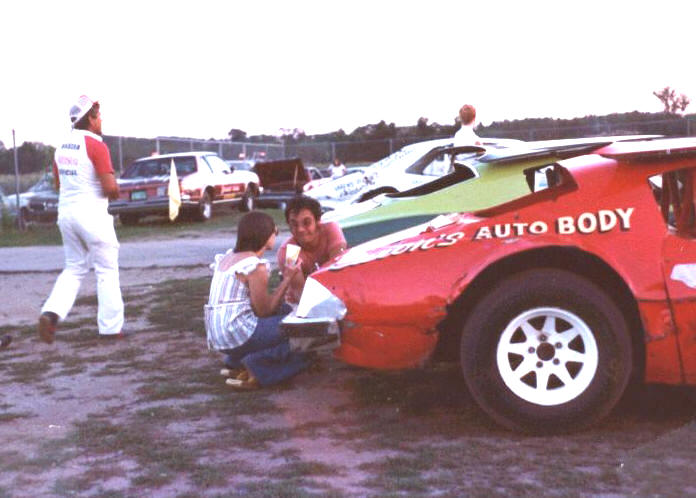
Courtesy of Mark Austin
Official Bubby Wilder
strolls by as Richard Buzzi chats with Deb Armstrong, a long - time supporter
of racing in northern Vermont. The son of legendary flathead racing mechanic
Libero Buzzi , Richard spun a brilliant wrench, himself.
Buzzi was an enormously popular figure in the pits at Catamount and Thunder
Road. I recall a very close relationship that grew up between his boys, Louie,
Cassani, Tank, and Harv, and the tough crew of Jimmy Barton, from Milton.
Buzzi would help anyone, if he had time. Waters still keeps one incident with
Buzzi fresh in his mind, almost thirty years after it occurred. He was leading
a race at Barre with Buzzi content to ride around behind him. Tom kept giving
him room, knowing Buzzi could blow by anytime he chose to. Waters remembers
looking in the mirror and having Richard raise a finger to him, signaling to
go ahead and take the win.
Tom says Buzzi knew he hadn’t won a race and
was willing to let him finish in first that night. As it turned out, Tom was
not going to accept a win that way and was ecstatic to finish second to Buzzi.
The cars the two or three top cars were running were more complicated than was
apparent to the casual observer. They had to run a stock type intake
and exhaust manifold when the div started. A 292 truck ex manifold was the
hot item. Some guys ran 2bbl adapters on the intakes; others, like Waters,
opened them up a bit and had a plate welded to the top.
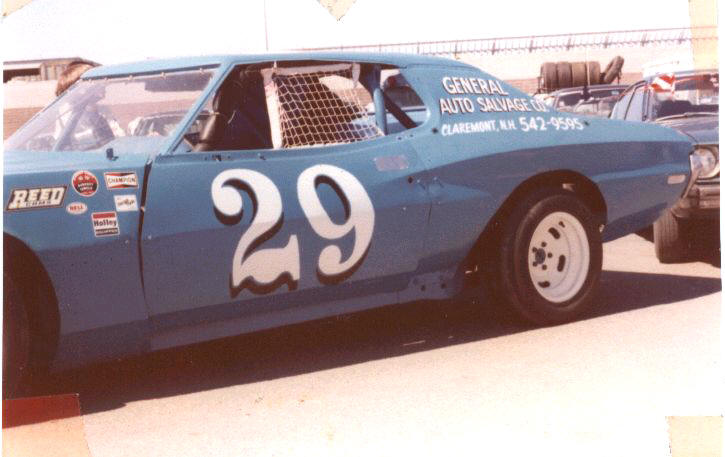
Courtesy of Mark Austin
Bruce Jaycox, from all
the way down in Woodstock, VT had one of the most unusual Grand Americans –
this big Ford. Note the sponsorship from soon – to – be LMS star Allen
Whipple’s salvage company. 34 years later, Bruce still races near home.
A lot of those cars had their own distinct
sound. While referring to the peculiar sound of Buzzi car, Waters explains
that - because of the way he built the interior in the Z28 car ( and to keep
from smashing the exhaust), his driver, Caron, built what amounted to 180
degree, over the bellhousing headers. The only other car they had heard with
that sound was the 6 cylinder Bear Ridge car Waters built..... because it ran
the same type of headers.
In the second year, around 1978, a Thetford, Vermont area man named Jim Vance,
a somewhat prominent figure at the Bear Ridge Speedway, decided to go out,
spend a wheelbarrow full of money on an Ed Howe - chassised Camaro, hire Bear
Ridge’s legendary Ervine “Brother” Eastman to drive, and go west to Catamount
to put Buzzi in his place. Waters recalls Vance calling him and spending what
seemed like hours grilling him on what to do with that kind of car on the
unfamiliar

Courtesy of Andy Boright
Vance’s Howe car fared
much better and suffered less body damage when Buzzi got in in 1979. But, the
core of the Grand American competition had been gutted for a while. Also
visible here are the 36 of Larry Lambert, Barton’s 57, and unknown pulverized
11, and Lanny Covey’s rough – looking 55. Probably Daryl Chapin next to the
51.
Waters wrote me, concerning Vance: “We
ran the Z28 car with 3.70 gears at Catamount. We were very close to the rpm
limit. I had three different 3 speed transmissions that all had different gear
ratios. We raced a
few times at Catamount with Vance and crew. I think Brother Eastman was
driving it for him.
Anyway, we
decided to change the rear end to a 3.43 ratio to get the rpm down just a
bit.. so the car would pull down the whole straightaway. Along with the rear
change, I changed transmissions to get closer to an effective 3.55 ratio or
so. The car flat out flew. Enough so that Jim noticed and came over asking
what we had done. "You must have changed gears" .
I was honest to a point, and said changed gears. Well, the next
week, Jim being Jim and thinking more is better.... he had different
gears...only he went the wrong way... he went to 4:11. 4:11 were good for
about halfway down the straights. I never did tell him.”
The Vance car won infrequently, and it looked like it had
been through the dryer at a huge Laundromat by the end of the season. The next
year, Buzzi was in the Vance car. He did not, however, return to his former
greatness with that car, winning only once. The division had – since its
inception – welcomed a number of other strong entrants. Essex Junction’s Joe
Myers had bought Ray Lasnier’s beautiful Rusty Jones Firebird and run it
successfully in the class for two years. That car was then traded to Norm
Andrews, who had suffered through a frustrating shot at the late models.
Andrews, in turn, sold it to Joey LaQuerre towards the end of the division’s
run in 1980.
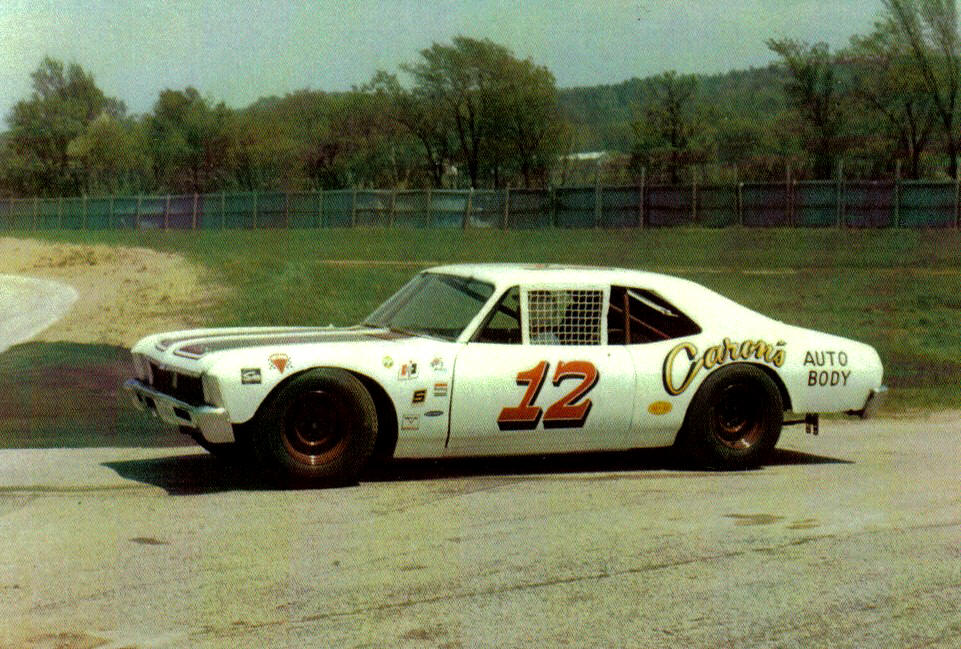
Courtesy of
Andy Boright
Larry Caron’s six
cylinder Nova was groundbreaking in several ways, but he really raised hell
with Waters’ Z28 Camaro, below.

Caron Family Photo
The Grand Americans would graduate such late
model drivers as LaQuerre, Larry Caron, Barney McRae, Aube, Andrews, and even
– to a limited extent – Jim Barton. Henry Van Acker would run in a late model
class at Airborne. Buzzi chose not to spend much time in the upper divisions,
probably due to budget considerations. Caron, with help from Waters, would
field a V-6 Nova late model sportsman which would run against the V-8’s at
Catamount’s brief Friday night series around 1980. The car had many motor
problems, and they switched over to a V-8; but, not long after, the late model
tour went through a period when it was all the trend to have a six cylinder
car for certain tracks.
Besides a few years of some of the finest
racing cars nobody paid much attention to, the notable legacy of the Grand
Americans was in the upcoming “New Tigers”, a class that started up in 1982
and was just hitting good stride when Catamount closed in 1987. At first a
hodge podge of everything from old street stocks, to old Grand Americans, to
cars bought from other tracks, to even a few newly – built cars, the guys
running their old Grand American cars were the class of the field until the
newly – built Tigers started coming out of shops like Chuck Beede’s.
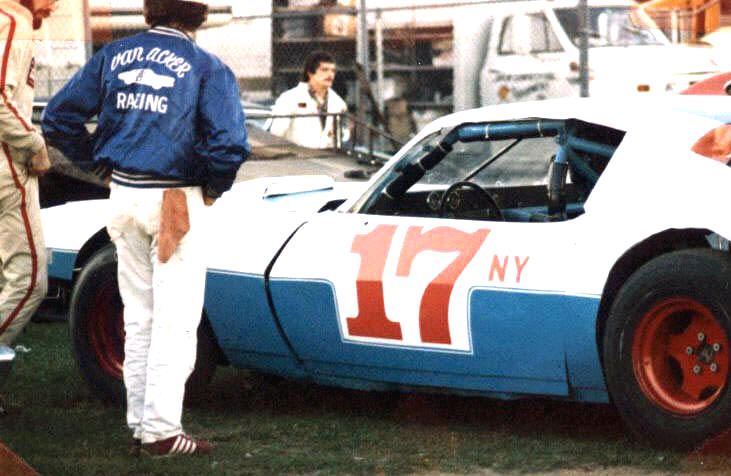
Henry Van Acker and
crew prepare the always – clean Camaro 17NY, with fellow New York competitor
Bob Wood in the background. Below – It didn’t always leave clean. Red Meade
checks out the mess.

When one looks at the feature winner lists in the division, it started out as
a fascinating mixture. 1977 and 78 saw Jay Yantz, Buzzi, Henry Van Acker,
George McRae, Paul Donahue, Dave Gibbs, Brother Eastman, Larry Caron, Joe
Myers, Jamie Aube, and even mini stock champ Harry Gammell winning. By the
final year, which ahd only nine GA events, five were taken by Norm Andrews.
The huge [Allen] lumbering street stocks became the only support show in town,
and the Grand Americans were either relegated to behind garages and barns, or
traveled off to other venues, as in the case of Joey LaQuerre and his ageless
Firebird.
No one can question what was accomplished
with these little cars, and some of the division graduates are still active
today. Aube actually still drives at Thunder Road, and the next generations of
Donahues and Carons race with him. Not that they necessarily care much, but
the management can look back and see guys like Larry Caron, Dave Gibbs, and
Red Mead as Grand American drivers who had faithfully supported them in
numerous support divisions since 1970. Seeing photos of beautiful cars like
Ray Lasnier’s #60 Rusty Jones Firebird, Waters’s 28, Caron’s Z28, Sonny
Gover’s #34 Camaro, or Henry Van Acker’s red, white, and blue 17NY gives
testimony to just how much these guys cared.
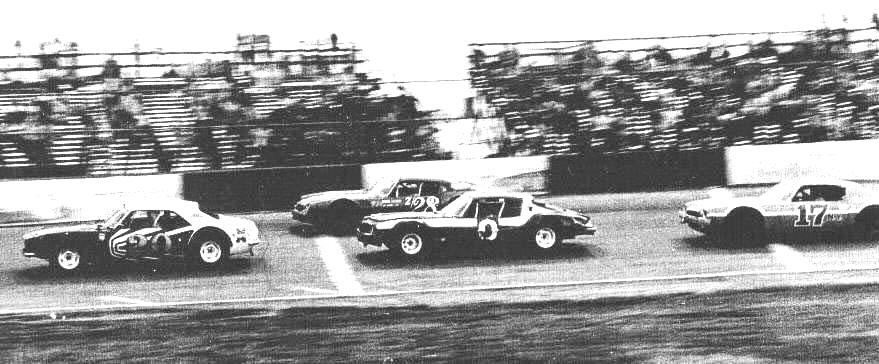
Both Photos
Courtesy of Andy Boright
A good shot from
the glory days of both the Grand Americans and Catamount Stadium. Below – The
same laboring, a year later, at a dying Thunder Road. The class supported
owner Tommy Kalimiris, but he was letting the place go to pot. Note the unmown
lawns, sparse crowds, and unpaid drivers.
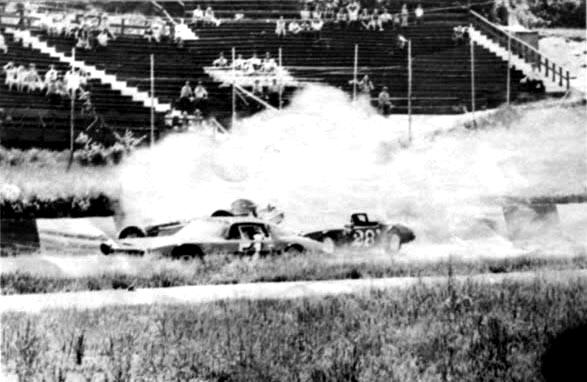
Please email me if you have
any photos to lend me or information and corrections I could benefit from.
Please do not submit anything you are not willing to allow me to use on my
website - and thanks. Email is:
wladabou@comcast.net . For those who still don’t like computers - my
regular address is: Bill Ladabouche, 23 York Street, Swanton, Vermont 05488.
